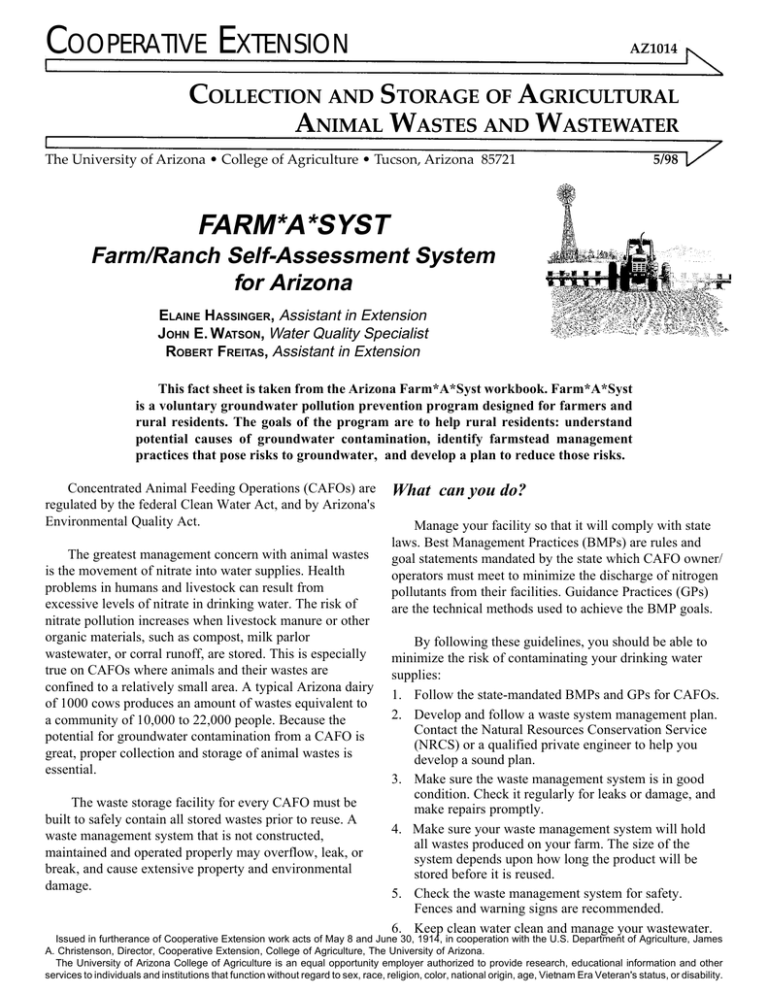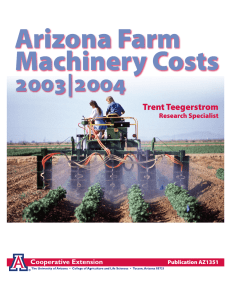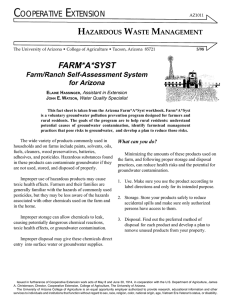C S A
advertisement

COOPERATIVE EXTENSION AZ1014 COLLECTION AND STORAGE OF AGRICULTURAL ANIMAL WASTES AND WASTEWATER The University of Arizona • College of Agriculture • Tucson, Arizona 85721 5/98 FARM*A*SYST Farm/Ranch Self-Assessment System for Arizona ELAINE HASSINGER, Assistant in Extension JOHN E. WATSON, Water Quality Specialist ROBERT FREITAS, Assistant in Extension This fact sheet is taken from the Arizona Farm*A*Syst workbook. Farm*A*Syst is a voluntary groundwater pollution prevention program designed for farmers and rural residents. The goals of the program are to help rural residents: understand potential causes of groundwater contamination, identify farmstead management practices that pose risks to groundwater, and develop a plan to reduce those risks. Concentrated Animal Feeding Operations (CAFOs) are regulated by the federal Clean Water Act, and by Arizona's Environmental Quality Act. The greatest management concern with animal wastes is the movement of nitrate into water supplies. Health problems in humans and livestock can result from excessive levels of nitrate in drinking water. The risk of nitrate pollution increases when livestock manure or other organic materials, such as compost, milk parlor wastewater, or corral runoff, are stored. This is especially true on CAFOs where animals and their wastes are confined to a relatively small area. A typical Arizona dairy of 1000 cows produces an amount of wastes equivalent to a community of 10,000 to 22,000 people. Because the potential for groundwater contamination from a CAFO is great, proper collection and storage of animal wastes is essential. The waste storage facility for every CAFO must be built to safely contain all stored wastes prior to reuse. A waste management system that is not constructed, maintained and operated properly may overflow, leak, or break, and cause extensive property and environmental damage. What can you do? Manage your facility so that it will comply with state laws. Best Management Practices (BMPs) are rules and goal statements mandated by the state which CAFO owner/ operators must meet to minimize the discharge of nitrogen pollutants from their facilities. Guidance Practices (GPs) are the technical methods used to achieve the BMP goals. By following these guidelines, you should be able to minimize the risk of contaminating your drinking water supplies: 1. Follow the state-mandated BMPs and GPs for CAFOs. 2. Develop and follow a waste system management plan. Contact the Natural Resources Conservation Service (NRCS) or a qualified private engineer to help you develop a sound plan. 3. Make sure the waste management system is in good condition. Check it regularly for leaks or damage, and make repairs promptly. 4. Make sure your waste management system will hold all wastes produced on your farm. The size of the system depends upon how long the product will be stored before it is reused. 5. Check the waste management system for safety. Fences and warning signs are recommended. 6. Keep clean water clean and manage your wastewater. Issued in furtherance of Cooperative Extension work acts of May 8 and June 30, 1914, in cooperation with the U.S. Department of Agriculture, James A. Christenson, Director, Cooperative Extension, College of Agriculture, The University of Arizona. The University of Arizona College of Agriculture is an equal opportunity employer authorized to provide research, educational information and other services to individuals and institutions that function without regard to sex, race, religion, color, national origin, age, Vietnam Era Veteran's status, or disability. Item 1. Corral or pen maintenance; grooming frequency. Question Yes No a. Corrals groomed at least twice each week. b. Corrals groomed less than once each week. 2. Mounds and slopes. a. Corral pens groomed with mounds and slopes to prevent ponding of water. b. No mounds or slopes present in corrals/pens, and ponded water is common. 3. Storm water storage. a. Storm water ponds or detention basins are lined with compacted clay or clay loam, or plastic liners. b. Storm water ponds and detention basins have no lining at all. 4. Site plan for entire facility. a. Site plan has been developed by Natural Resources Conservation Service or qualified private engineer. b. No site plan exists. The questions listed above can help you determine whether your management practices in the collection and storage of animal wastes may pose a risk to groundwater. Take a few minutes to complete the questions. If you answered yes to mostly "a" questions, your groundwater is probably safe from becoming polluted from your management practices. If you answered yes to mostly "b" questions, then your groundwater may be at high risk of becoming polluted. Worksheet number six in the Farm*A*Syst book will give you a more complete assessment of animal waste management practices on your property. If you are interested in obtaining a copy of Arizona's Farm*A*Syst workbook, please contact the College of Agriculture's Publications Distribution Center, 4042 North Campbell Avenue, Tucson, Arizona 85721. The office phone number is (520) 621-1713 and the FAX number is (520)7958508. The cost of the workbook is $5.00 plus shipping. Contact your county extension office or NRCS office if you have questions about how to use the workbook. Any products, services, or organizations that are mentioned, shown, or indirectly implied in this publication do not imply endorsement by The University of Arizona.








